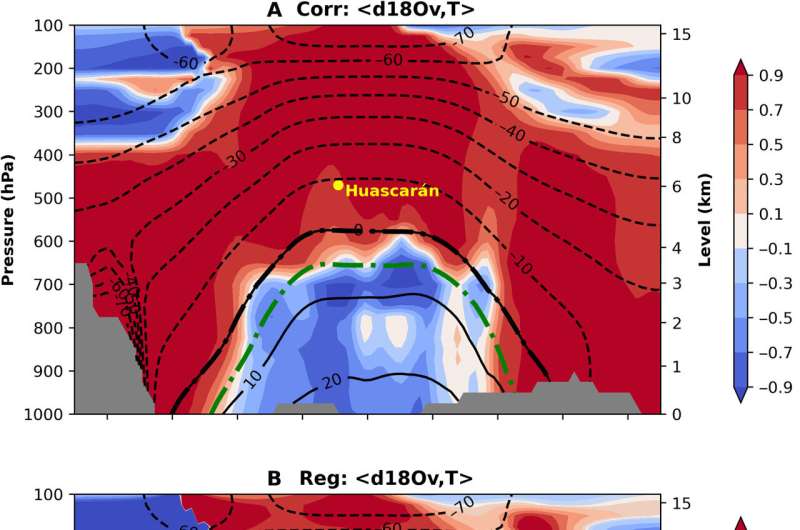This article has been reviewed according to Science X's editorial process and policies. Editors have highlighted the following attributes while ensuring the content's credibility:
fact-checked
peer-reviewed publication
trusted source
proofread
Tropical ice cores offer deeper insights into Earth's temperature record

A new study suggests ice recovered from high tropical mountains can reveal key insights about Earth's past climate changes.
Led by scientists at The Ohio State University, the study showed that oxygen-stable isotope records stored in tropical mountain glacier ice cores can be used to provide scientists with a distinct paleoclimate history of the planet's middle and upper troposphere. By combining ice core proxy records, paleoclimate simulations and modern satellite measurements and comparing the results to those from previous climate models, they found that the temperature in this region of the atmosphere cooled by 7.35°C during the Earth's glacial period, which for many researchers illuminates new theories about climate dynamics throughout the ages.
"Typically, you need hundreds of pieces of data to construct a record of global mean temperature," said Zhengyu Liu, lead author of the study and a professor of geography at The Ohio State University. "It turns out, in that region in the tropics and at that height, you can use just one, and it's very consistent with many other independent constructions available, which rely primarily on sea surface temperature proxies."
Because the ice core, collected from Nevado Huascarán in Peru, was formed in a high-mountain region disconnected from the oceans, samples recovered there are essentially unique "Goldilocks-type" indicators of global mean temperature change.
Unlike ice recovered from opposite extremes of the planet such as Greenland or Antarctica, ice from tropical regions provides a happy medium, and holds evidence that is "just right" for measuring Earth's mean temperature throughout the ages. More importantly, said Liu, their findings show the first solely land-based estimate of global stage cooling, or how much Earth's temperature decreased during its last glacial period.
The study, which was published recently in Science Advances, and presented in a poster session today (Dec. 14, 2023) at the annual meeting of the American Geophysical Union, found that surface temperatures during Earth's glacial cooling stages diminished by as much as 5.9°C.
"This ice core is like a weather tower quietly recording atmospheric history," said Liu. According to the study, since the highest tropical ice records are not affected by regional features of the warming environment due to their unique elevation and location, the information these "weather towers" collect is considered to be a more accurate measurement of surface global mean temperature as opposed to records that reflect regional changes.
It's for this reason that information gained from even a single tropical ice core could likely be used to enhance scientists' understanding of a number of different climate elements, including temperature responses during periods of rapid climate change such as the one occurring today as well those likely to occur in the future, said Lonnie Thompson, co-author of the study and professor of Earth sciences and a senior research scientist at the Byrd Polar and Climate Research Center.
Potent greenhouse gases such as methane, large sources of which come from tropical wetlands, are also preserved in the bubbles in these very high-elevation ice cores where temperatures are very cold and no melting occurs. But by extracting the methane from the ice cores, scientists can construct a history of the changes in its atmospheric concentration. According to Thompson, as methane is a very potent greenhouse gas that can warm the atmosphere at alarming rates, it's important to have a tropical archive of its past activity.
"Integrating these tropical records with those from the polar regions provides a more global picture," he said. "Thus, acquiring these high-elevation tropical climate histories is very important as their data will greatly advance our understanding of Earth's climate on this planet."
The study's conclusions also shed light on a decades-old scientific debate on how oxygen-stable isotopes in tropical ice cores can be used to interpret climate variations over time. Previous studies have debated whether tropical ice core samples serve as proxies for determining atmospheric changes through either temperature or precipitation processes. This study suggests the tropical ice cores serve as a recorder of air temperature in the mid-upper troposphere across tropics, and more interestingly, as a recorder of global mean surface temperature during Earth's last glacial period.
Altogether, the study aims to improve researchers' understanding of paleoclimatology, as a better understanding of Earth's climate patterns could help refine both future climate models and extreme weather predictions.
Yuntao Bao, another co-author of the study and a Ph.D. student in geography at Ohio State, said that their research wouldn't have been possible without the input of colleagues across many other fields, not just those in the scientific community interested in studying ice cores.
"The answer to your questions will not come to you the first time, but collaborating with others who have different backgrounds than our own improves our understanding of the world," said Bao. "With more perspectives, our future work can reach further than it's ever gone."
More information: Zhengyu Liu et al, Tropical mountain ice core δ 18 O: A Goldilocks indicator for global temperature change, Science Advances (2023). DOI: 10.1126/sciadv.adi6725
Journal information: Science Advances
Provided by The Ohio State University




















